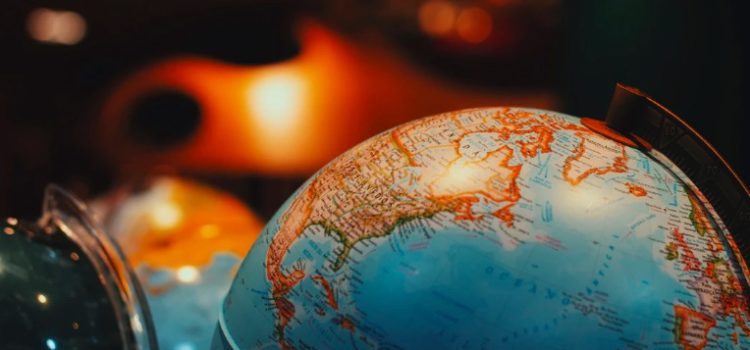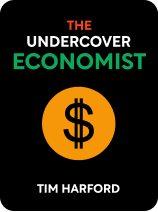

This article is an excerpt from the Shortform book guide to "The Undercover Economist" by Tim Harford. Shortform has the world's best summaries and analyses of books you should be reading.
Like this article? Sign up for a free trial here .
What exactly is globalization? How does the increasing globalization affect the economies of individual nations?
Globalization can refer to many kinds of exchanges among nations, but we will define it as more trade between nations and more direct investment in other nations. Usually, trade and direct investments take place between rich countries. However, globalization is starting to influence poorer countries as well.
We’ll discuss globalization and economy, how globalization has changed the way the world economy functions, and then move on to the case studies of Cameroon and China.
Globalization and the Comparative Advantage
Much of the success of globalization is due to comparative advantage. Comparative advantage occurs when one group can make a product more efficiently than another group. We’ll use a simple example of building radios and televisions to illustrate this concept. Let’s say that in the United States, a factory worker can build a radio every 30 minutes and a television every hour. In China, a factory worker can produce a radio every 20 minutes and a television every 10 minutes. Without trade, it will take the worker 90 minutes to make television and a radio in the U.S. and 30 minutes to make both in China. However, let’s say that the Chinese worker decides to make two televisions and the American worker makes two radios, and then they trade, swapping a TV for a radio and vice versa. Now, the Chinese worker has a radio and a TV in 20 minutes (as opposed to 30 minutes), and the American worker has a TV and a radio in an hour (as opposed to 90 minutes). Both win. If we disallow trading, we’re hurting everyone.
Certainly, the subject of globalization and the economy is much more complex than this simple example. We use currency and trade with multiple partners, which both obscure this simple principle. However, despite these added complexities, the general principle holds true.
Additionally, when nations put taxes on imports, they are unknowingly placing an equal tax on their exports. Nations have trouble selling their products when they won’t buy anyone else’s without high taxes. This is called the “Lerner Theorem” after economist Abba Lerner, who developed it in 1936.
For example, if the U.S. puts a high tax on imports of Chinese TVs, effectively banning them, the American TV-making industry will benefit (people will buy the cheaper American TVs rather than the expensive Chinese ones). However, U.S. export industries will suffer: Say the U.S. exports radios in exchange for Chinese currency. Without Chinese imports to spend that currency on, the American industry’s revenue from China is essentially useless.
Industries are thus competing with others in their own nation for comparative advantage. Factories in the U.S. that build radios will only survive in the long run if they can be more efficient than factories that build televisions. This is because, in the free market, consumers can get their products from more efficient factories overseas.
(Shortform note: To learn more about the negative consequences of tariffs, read our summary of Economics in One Lesson.)
Unfortunately, given the struggle for efficiency, some workers do lose their jobs in the globalized free market—it’s not good for everyone right away. These workers are forced to learn new skills and hope that more efficient producers that now have more demand from around the world will hire them. The government should help people who lose their jobs while continuing to pursue globalization.
Why Globalization Is Good
Principles of comparative advantage highlight the positives of globalization. But globalization still has its skeptics. Mostly, skeptics focus on the arguments that globalization is bad for the planet and bad for the poor.
The Case of the Planet
People who argue that globalization is bad for the planet list the following reasons for concern:
- Globalization creates a “race to the bottom.” The companies that can produce goods the cheapest are the only ones that succeed, and it’s easier to produce cheap goods with less stringent environmental regulations.
- The act of moving goods from place to place creates more pollution. This happens more in a globalized world.
- The economic growth that comes from globalization is bad for the planet because it necessitates building more polluting factories and more consumption.
Here are the reasons why each of these arguments is misguided:
- Most trade happens between rich countries that have similar regulations on pollution. Companies are playing on an even playing field. Additionally, any additional costs that come from government regulations on pollution are generally negligible. Most of the cost of producing a good comes from the cost of labor. When companies move, they almost always do so to find cheaper labor rather than to find less stringent environmental regulations. Additionally, protectionist policies like giving government subsidies can encourage pollution. To keep foreign goods, which are manufactured more efficiently, out of a country, the government essentially pays polluters to continue polluting.
- There is nothing that is uniquely damaging to the environment about crossing a national border. It is an environmental problem that more goods move further in a globalized world, but instead of cutting movement off at borders, governments should charge externalities (discussed in Chapter 4) inside and outside of their countries.
- The deadliest environmental problems, such as unclean drinking water, actually affect the poorest people in the world the most. Economic growth can help with these problems. As people become wealthier, they no longer have to rely on unsafe drinking water. Admittedly, there are some problems, like fumes from car exhausts, that get worse as people get a bit richer. But as they get richer still, they can start to afford to buy cars that don’t cause as much pollution. The bottom line is, it’s not worth keeping people in poverty to attempt to solve the environmental crisis. Plus, it’s not a binary equation, given that there’s no need to choose between one or the other. As discussed in the last answer, we can raise externality taxes and use those taxes to work on our environmental issues.
Rather than fear free trade, environmentalists should embrace it.
The Case of the Poor
Some anti-poverty advocates argue that multinational corporations keep people poor by paying them poor wages. This is not the case; multinational corporations are not the cause of poverty. People accept work at sweatshops because they have no better options. And in fact, when there are more factories that belong to multinational companies in developing countries, wages begin to rise because of an increase in competition. Rather than chastise companies for developing in poorer nations, we should encourage this behavior.
When a group of people decides to buy only “fair trade” goods, this adversely affects sweatshop workers more than anyone else. If people buy more “fair trade” goods, then there’s less demand for the goods that sweatshop workers make, and companies can either pay them lower wages or shut down their factories. Tariffs that stop people from buying sweatshop goods only benefit some unions, who have outsized political power in many developed nations. When special interests like unions have less power, governments always lower tariffs and promote free trade.
(Shortform note: To learn more about how international trade can improve standards of living around the world, read our summary of Naked Economics.)
Case Study: Cameroon
Economists and those who live in or have an interest in Cameroon and its people are curious about the same two questions: Why is Cameroon poor? And what can we do to make it less poor? We’ll explain Cameroon’s problems and how globalization could help Cameroonians.
To answer these questions, we’ll begin with the current state of the Central African nation. Currently, Cameroon has few good roads. The roads that are paved are littered with potholes and shopkeepers who have set up their business in the middle of the street. There are no rules that govern traffic. The Cameroonian president, Paul Biya, has been in power since 1982. Amnesty International grades the country as one of the most corrupt nations in the world.
Cameroonians by and large hate their government because it doesn’t provide them with basic services. They believe that it is riddled with corruption that begins with Biya. Biya, though, does have some incentive to help the nation thrive to an extent. Even if he is purely self-interested and a complete bandit, he doesn’t steal everything from his people, because then there will be nothing to take the next year. A nation with a successful economy would lead to more profit for Biya.
The problem is, Biya is not in as much control as many of his people believe. He is the head of the government, but to stay in power, he has to please many actors—in particular the civil servants and the military below him—to stay in power. Biya might prefer that the police department, for example, solicit fewer bribes. However, he needs the backing of the police to hold onto the nation, so he has to allow their corruption to protect his own. Certainly, Biya doesn’t have the best interests of Cameroon at heart. His taxes are arbitrary and discourage investment, and he tolerates corruption from all parts of government to stay in power. But while the rife corruption comes from the top, it extends well beyond Biya.
Strong Institutions
Some economists argue that wealth is simply the combination of:
- Created resources (such as roads)
- Human resources (such as education)
- Technological resources (such as specific machinery and technological know-how)
If we model economic advancement based on the above resources, it stands to reason that poor countries like Cameroon would naturally catch up with the rest of the world due to diminishing returns. In a developed nation like the United States, there are already many roads, decent education systems, and a lot of technological know-how. Investment into new infrastructure, for example, might help the country move forward a bit, but not nearly as much as building a well-paved and safe highway through the middle of Cameroon would do for them.
Thus, there’s another reason why Cameroon stays poor: the absence of strong institutions. Weak institutions that are rife with corruption stop Cameroon from catching up with the rest of the world.
World Bank economists argue that poor countries should make a “big push” to catch up, meaning they should invest in all of the above resources all at once. This is a good theory, and it might help to a degree, but a case study in Cameroon explains why even with investment, weak institutions lead to stagnation.
A Terrible Library
At one of Cameroon’s fancier schools, there’s a library without any books in it. From the outside, this library looks beautiful. It has a fancy design, and it’s one of two buildings on campus that is taller than one story.
However, the library is unusable. Its design mistakenly created a gutter that directs rain right onto the middle of the roof. The library is only four years old, but it’s filled with leaks, and the inside is musty. Books couldn’t survive one rainy season inside the new library. The campus has an older library, where the librarian continues to keep the books.
The building of the library was plagued with systemic problems. The principal of the school wanted to convert the school into a university, so he needed an impressive building. The principal controls all of the hiring and the firing, and the teachers wanted to keep their jobs, so they couldn’t disagree with the design. Additionally, the principal is part of what Cameroonians call the “Bafut Mafia.” Most education professionals are from the Bafut region and know one another. The principal was thus able to find money for the library based on his social network. This incident proves that Cameroon doesn’t have any institutions that can hold self-interested people in check.
Kleptocracy makes sure that poor countries stay poor. Laws don’t encourage development and no one establishes official businesses for fear of taxation. These problems explain the gap between rich and poor countries. A meritocracy would begin to solve these problems, but there is none in Cameroon.
Cameroon has manifest economic problems, some of which could be solved by undertaking legal reforms or making it easier to set up businesses. But the best way to lift a nation like Cameroon out of poverty is through globalization.
Case Study: China
China is in a period of intense economic growth. Once a poor nation, it has managed to pull itself out of poverty, and it now has a lot of economic power that continues to grow. China’s rail system is state of the art and they are attracting all kinds of foreign investment—things are good. So, how did they pull themselves out of poverty?
The Great Leap Forward
To understand where China is now, we have to move back in time. For a long time, China was closed to free trade. In the late 1950s and early 1960s, China, ruled by Communist leader Mao Zedong, enacted economic policies that he called “The Great Leap Forward.” He attempted to take advantage of China’s comparative advantage in iron production and agriculture by refocusing the entire economy. He forced his citizens to melt down all kinds of basic items they used in their day-to-day lives in village furnaces in service of the state. The plan failed miserably and resulted in a famine that left a death toll of between 10 million and 60 million.
Liberalization
After Mao Zedong died in 1976, Deng Xiaoping ascended to the head of China’s government. He embarked on a policy of liberalization, which consisted of slowly shifting China’s economy from a complete command economy (state controlled) into a market-based system. He did so by maintaining state ownership over factories but allowing them to make their own choices. Efficient firms that surpassed their state-created production targets used that extra revenue to expand, while the Chinese government continued to prop up inefficient firms.
This was an attempt to gradually foster competition, as firms wanted to expand more quickly than their neighbors, and it worked well. Production increased in many places. It was not privatization, but competition, that drove much of China’s economic growth.
Opening the Nation
Satisfied with the results of his early liberalization policies, Deng Xiaoping began to let in private firms from other nations to compete with the state-run Chinese firms and other firms that were owned by local governments and townships. Foreign firms succeeded, and Chinese firms held their own. As this policy worked, China allowed more foreign investment. They maintained competitive advantages—labor is cheap in China—and used them to tap into the world economy and grow quickly. They also began to use foreign technology to get as efficient as possible. The government committed to education and had enough money to build infrastructure like the high-speed rail system.
Special Economic Zones (SEZs)
As part of China’s opening, they used a strategy of Special Economic Zones (SEZs) to foster growth. Because China still operates partially under a command economy, they had to establish geographic areas, or SEZs, where the command economy didn’t apply, and the market could reign free. They used their geographic proximity to Hong Kong and Taiwan, both free market-driven nations, and placed large SEZs right next to each of those nations. This way, they managed to reap the benefits of the free market while maintaining some state control.
The SEZs helped reforms and wealth spread throughout China. These are important because they made people’s lives better.
All of these economic principles—scarcity, price targeting, finding efficient markets, externalities, missing information, the stock market, game theory, and globalization—may have seemed impossibly complex before reading this summary. But The Undercover Economist proves that while economics can sound full of jargon, it is ultimately about people.

———End of Preview———
Like what you just read? Read the rest of the world's best book summary and analysis of Tim Harford's "The Undercover Economist" at Shortform .
Here's what you'll find in our full The Undercover Economist summary :
- How to think like an economist
- How to use principles like scarcity, price targeting, the stock market, and game theory to make better decisions every day
- Why the economy is mostly about people, not complex math, graphs, or jargon






